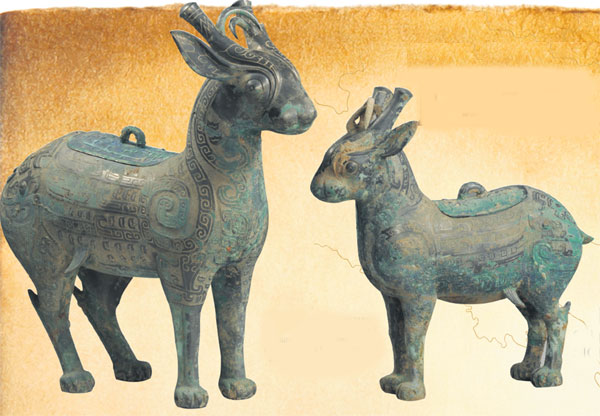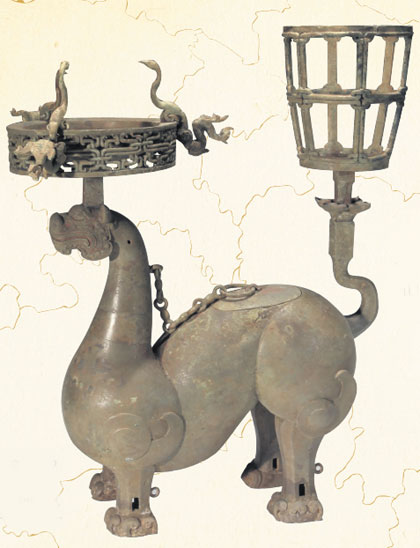History unearthed
Updated: 2014-04-17 07:21
By Wang Kaihao (China Daily)
|
||||||||
The Top 10 archaeological discoveries of 2013 have been unveiled. From ancient tombs to valuable engravings, they provide a snapshot of the valuable relics buried beneath the earth in China. Wang Kaihao reports.
The Top 10 list of archaeological discoveries in China in 2013 was announced by the State Administration of Cultural Heritage last week, a prize which has been dubbed by media as "the Academy Awards of Chinese archaeology". "Having a strong public impact is only a part of our criteria, which emphasizes a candidate's academic significance. So some of the more widely talked about discoveries, such as Tomb of Shangguan Wan'er - China's woman prime minister in the Tang Dynasty (AD 618-907) - are not included in the final list," says Wang Wei, director of the Institute of Archaeology under the Chinese Academy of Social Sciences and a member of the 21-member judging panel. The panel also includes scholars from various institutions, including Peking University, the Palace Museum and the National Museum of China. "This list attracts public interest and enhances awareness of the importance of protecting cultural relics. It is a little unusual that the list doesn't include any Neolithic or earlier relics this year, though some candidates belonged to that period," says Tong Mingkang, deputy head of the State Administration of Cultural Heritage. "Those were also great discoveries, but some of the discoveries from later dynasties are too extraordinary. It's really difficult to select the final 10 items in such a close competition." China Cultural Relics News, which is affiliated to the administration, has organized the annual event since 1990. Here we present 2013's Top 10 archaeological discoveries (ordered by period of time), with comments from the project leader of each dig:
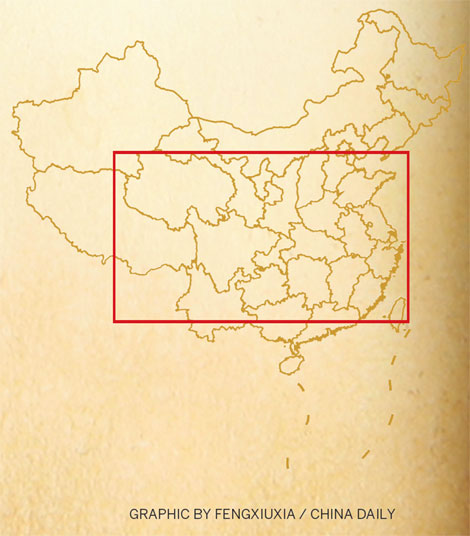
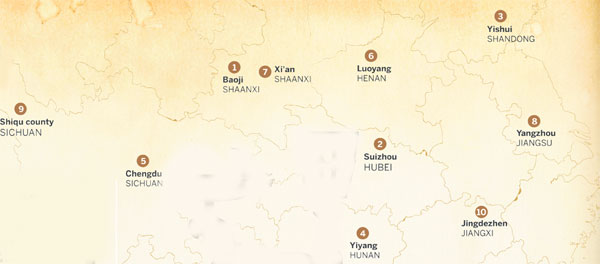
|
The set of animal deity-shaped drinking vessels is one of the most precious finds from the Shigushan Tombs in Baoji, Shaanxi province. Photos Provided to China Daily |
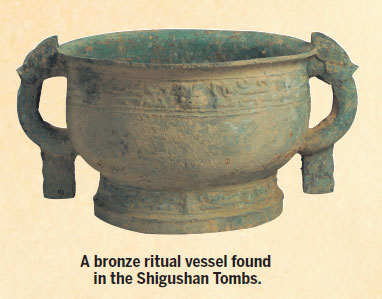
1. Shigushan Tombs of the Western Zhou Dynasty (c. 11th century-771 BC), Baoji, Shaanxi province
Fifteen tombs were unearthed in the southern outskirts of Baoji, containing about 230 articles of cultural significance, including 92 bronze ritual vessels and 26 pieces of epigraphy and family crests.
The tombs are believed to have belonged to ancient tribes in western China, which had adopted the rituals of the royals of the Western Zhou Dynasty.
One of the most precious finds is a set of animal deity-shaped drinking vessels. These are unusual because some of the styles had not previously been found in Baoji and others had never been seen in China before. Their discovery "has rewritten the textbook on bronze ware", says Wang Zhankui, a researcher from the Shaanxi Provincial Institute of Archeology.
"Different civilizations are seen in the relics like chopsticks are put together with a knife and fork on today's dining table," Wang says. "It offers us the perfect model to study ethnic cultures in the Bronze Age, and adds a splendid chapter to our studies of the politics and historical geography at that time."
|
A copper lamp from the Wenfengta Tomb, Suizhou, Hubei province. |
2. Wenfengta Tombs of the Eastern Zhou Dynasty (770-256 BC), Suizhou, Hubei province
About 60 tombs were found in Hubei province during urban construction. The relics belong to the ancient state of Zeng, which became known across the globe for its delicate bronze bells called bianzhong that were found in the tomb of Marquis Yi, which was unearthed in 1978.
Other tombs from the same period had previously been uncovered, but what makes this discovery unique is that these tombs display different characteristics. A tomb of another marquis, who lived in a later period than Marquis Yi, was also found.
The finds are also the biggest discovery of Zeng's bronze ware in recent decades. Archaeologists can trace the relics back to their owners.
"The discovery fills the gap of historical recordings of the Zeng state between the earlier Western Zhou Dynasty and later periods of time," says Huang Fengchun from the Hubei Provincial Institute of Archaeology. "It also solves many mysteries bothering archeologists for a long time and will reconstruct our understanding of the overall history of Zeng."
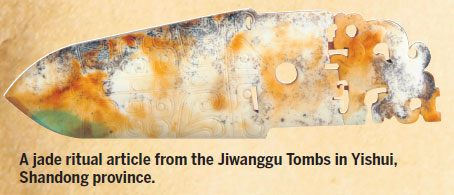
3. Jiwanggu Tombs of the Spring and Autumn Period (770-476 BC), Yishui, Shandong province
The tomb is located in a mountainous area with a unique landscape. The bigger of the two pits is 40 meters long and 13 meters wide.
The relics are distinctive among the tombs from similar periods of time due to their unusual structure: The coffin chamber and pits burying sacrificial horses and carriages are in the same cave on a slope.
Nearly 200 cultural relics were unearthed, including bronze ware, jewels, jade, and four carriages, each with two horses.
"This high-level tomb is among the biggest archaeological discoveries in Shandong province in recent years," says Hao Daohua, a researcher from the Shandong Provincial Institute of Archaeology.
"What amazes us most is its burial shape, which has never seen before and will help unveil the truth behind some historical legends surrounding the area."

4. Tuzishan Relics, from the Warring States Period (475-221 BC) to the Wu Dynasty (AD 220-280), Yiyang, Hunan province
Sixteen ancient wells have been discovered at the relics site, and 11 of them contain about 15,000 bamboo slips, traditionally used to keep records. The bamboo slips are from several dynasties.
The slips include a proclamation of accession by the second emperor of the Qin Dynasty (221-206 BC) and records of wars at the end of that dynasty, plus numerous government and legal documents, from different periods of time.
Many other relics, including copper mirrors, eave tiles, as well as animal and plant specimens, were also found in the wells.
"It's no exaggeration to say the relics themselves present a history of bamboo slips and calligraphy," says Zhang Chunlong, a researcher from the Hunan Provincial Institute of Archaeology. "The period of upheaval in the late Qin Dynasty and many historical events are vividly presented via these files. It will greatly help us better understand that time's political system of local governments as well as historical geographic names."
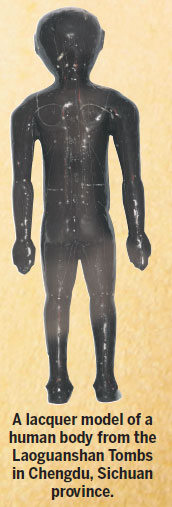
5. Laoguanshan Tombs of the Western Han Dynasty (206 BC-AD 24), Chengdu, Sichuan province
Four tombs were uncovered and nine sets of ancient medical books made of wooden and bamboo slips were discovered, on which appear more than 20,000 characters. A lacquer model of a human body for traditional Chinese medical use is the earliest item of its type found in China so far. The files are believed to belong to the Bianque School, a legendary medical school once believed to be lost forever as no documents relating to it had ever been found.
Four sets of loom models were also unearthed, which are so far the nation's only discovery of complete looms from the Han Dynasty (206 BC-AD 220) with clear archaeological recordings.
"A medical legend came back to the world, and it is a milestone for the study of the origins of TCM acupuncture, and even the overall history of TCM," says Xie Tao, deputy director of the Chengdu Municipal Institute of Archaeology. "Sichuan is traditionally known for its delicate silk pieces. The models present the highest weaving technique at that time and are an extraordinarily crucial part of the history of silk."
6. Hanguguan military pass relics of the Eastern Han Dynasty (AD 25-220), Luoyang, Henan province
This military pass leading to the Silk Road had important strategic significance, and has been repeatedly documented in historical files. The excavation found 17 sections of walls built by rammed earth and two ancient roads and a large number of other construction components. The eastern wall is 22 meters thick. One road was rammed as many as 12 times, and was 2.3 meters thick. Clear evidence of former residents' activities was also detected.
"Studies on ancient military passes are severely lacking in China," says Yan Hui from the Luoyang Municipal Institute of Archaeology. "This discovery provides an important reference to further relevant academic research and relic protection, and will probably help the ancient Silk Road bid for UNESCO World Heritage."
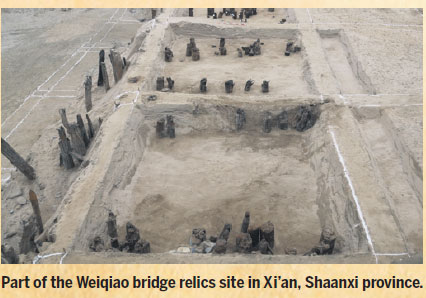
7. Weiqiao bridge relics from the Western Han Dynasty (206 BC-AD 24) to the Eastern Han Dynasty (AD 25-220), Xi'an, Shaanxi province
Evidence of seven bridges was found on what was once the course of the Weihe River. Strangely, five of them are located within a short distance of 400 meters. The longest one was 880 meters long, and believed to be the world's longest bridge built with wooden beams and columns. These were also the first bridges from Chang'an (today's Xi'an) westward via the Silk Road.
Numerous vestiges of repair were observed, ranging for several successive dynasties. Discovery of 17th-century coins in the riverbed proves the Weihe River did not change its current course earlier than that period of time.
"The discovery fills the academic void on ancient bridges of Chang'an, the capital of so many dynasties in China," says Liu Rui, a deputy researcher with the Institute of Archaeology under the Chinese Academy of Social Sciences. "It was where many historic incidents occurred, and the discovery will also help us better understand how the local natural environment changed in ancient times."
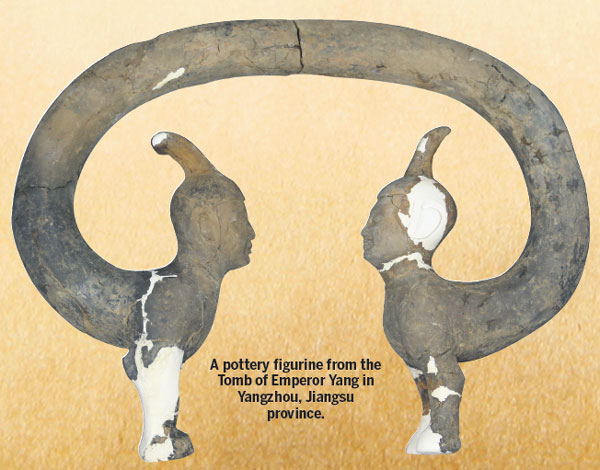
8. Tomb of Emperor Yang of the Sui Dynasty (AD 581-618), Yangzhou, Jiangsu province
The last emperor of the Sui Dynasty is probably one of the most notorious tyrants in Chinese history, though recent academic studies have portrayed a more neutral image of this controversial figure, who ordered the construction of the Grand Canal.
The two tombs were believed to belong to this emperor and his queen, due to the unearthed remains, epigraphy and valuable sacrificial items.
About 600 sacrificial items were discovered, among which some have strong local characteristics particular to Yangzhou. They are different from those from the Sui Dynasty's capital city of Daxing (today's Xi'an). One 13-knot gold-and-jade belt is the only complete belt of its type ever found in China. It is an example of the highest-level belt available in that time period. Bronze bells from the Sui Dynasty were discovered for the first time.
"The findings prove relevant historical recordings and offer much first-hand information about high-level tombs in that period of time," says Shu Jiaping, head of the Yangzhou Municipal Institute of Archaeology. "It will greatly enrich the cultural significance of Yangzhou."
9. Shiqu rock engravings of the Tubo Kingdom (7th to 9th century), Shiqu county, Sichuan province
Three rock engravings from the Tubo Kingdom were found in three different locations in Shiqu county. The one found on the Xubashan Mountain site, which consisted of 13 engravings, is the most important. It features a large number of Buddhist images and totems that provide valuable information. The documents, written in ancient Tibetan, also contain information that helps identify these engravings' ages.
One engraving is a record of precious Buddhist eulogies written in ancient Tibetan and is one the best-preserved relics of its type ever found.
"The location of the ancient route between the Tubo Kingdom and the Tang Empire was ambiguous due to the lack of records, despite the discovery of some scattered relics in the nearby area," Gao Dalun, head of the Sichuan Provincial Cultural Relics and Research Institute, explains.
"However, these rock engravings give us new information. We've got much more information on bilateral relations between the Tang and Tubo, as well as the history of Buddhism in the area. It also creates a model for protection of cultural relics in areas inhabited by non-Han ethnic groups."
10. Nanyao porcelain kiln relics of the Tang Dynasty (AD 608-907), Jingdezhen, Jiangxi province
The site is spread over 30,000 square meters and is among the biggest ancient porcelain kiln relics in the province. One 78.8-meter-long kiln is the longest Tang Dynasty kiln of its type ever found.
The workshop dates back to 1,200 years ago. Porcelain production in Jingdezhen, considered to be ancient China's "porcelain capital", is said to have begun 2,000 years ago, a date suggested by historical records. Until the finding of the Nanyao site, however, the porcelain production in Jingdezhen can only be archaeologically dated to 1,000 years ago.
"These kiln relics, the earliest ever discovered in Jingdezhen, are an important supplement of orthodox history and help us determine how the porcelain industry developed here," says Zhang Wenjiang, a researcher with the Jiangxi Provincial Institute of Archaeology.
"We also found a crucial file on the overall development of the porcelain industry in the Tang Dynasty."
Contact the writer at wangkaihao@chinadaily.com.cn.
(China Daily 04/17/2014 page18)

 'Taken 2' grabs movie box office crown
'Taken 2' grabs movie box office crown
 Rihanna's 'Diamonds' tops UK pop chart
Rihanna's 'Diamonds' tops UK pop chart
 Fans get look at vintage Rolling Stones
Fans get look at vintage Rolling Stones
 Celebrities attend Power of Women event
Celebrities attend Power of Women event
 Ang Lee breaks 'every rule' to make unlikely new Life of Pi film
Ang Lee breaks 'every rule' to make unlikely new Life of Pi film
 Rihanna almost thrown out of nightclub
Rihanna almost thrown out of nightclub
 'Dark Knight' wins weekend box office
'Dark Knight' wins weekend box office
 'Total Recall' stars gather in Beverly Hills
'Total Recall' stars gather in Beverly Hills
Most Viewed
Editor's Picks

|
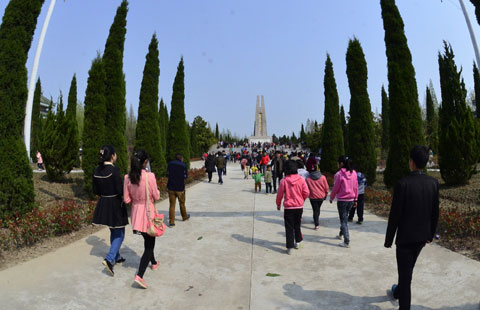
|

|
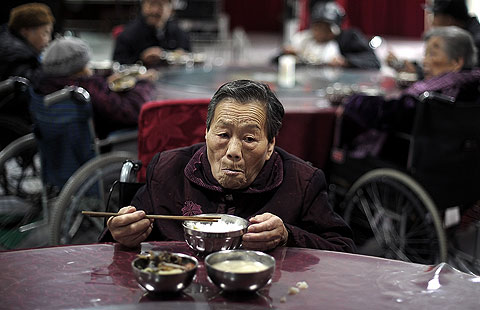
|

|
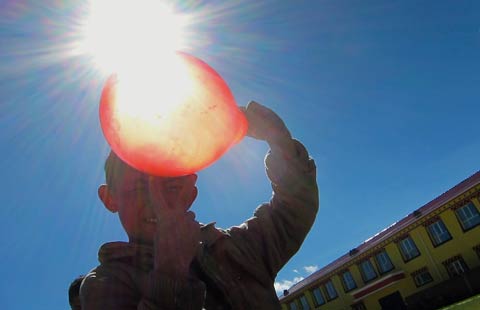
|
Today's Top News
US Treasury declines to name China as currency manipulator
Solar power surging in Latin America with World Cup fever
Internet recruiter aims for base of millions
US schools still draw Chinese
China's CITIC acquires stake in NY brokerage firm BTIG
Chinese automakers pass on New York auto show
China sells more of its US debt in Feb: Treasury
Tesla in search of deal with Sinopec
US Weekly

|

|
